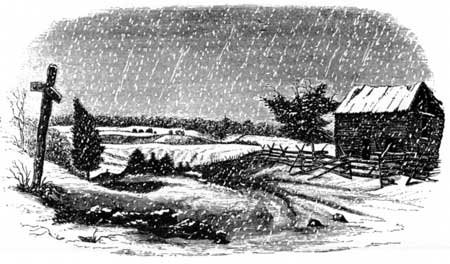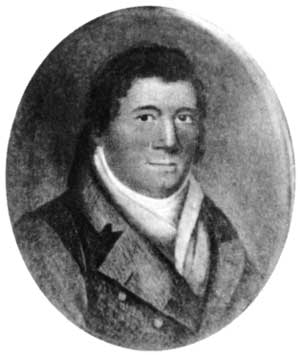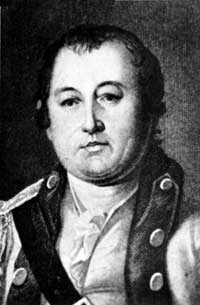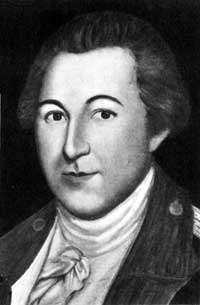|
GUILFORD COURTHOUSE National Military Park |
 |

The battlefield at Guilford Courthouse as it
appeared in 1854.
From Lossing's, A Pictorial Field Book
of the American Revolution. Sketch by Benson J. Lossing.
Attack on the Third Line
Withdrawal of the second line opened the way for the advance against the third. This last line was entirely north of the road and was opposed by the British left wing. Heavy woods and several gullies of considerable size served to slow up the advance, particularly that of the Welch Fusiliers. The 2d Battalion of the Guards made contact with the left units of the American line almost simultaneously with the attack on the American right by the Yagers, the Light Infantry, and the 33d Regiment. A general engagement resulted in which the contest was more nearly equal than any which had preceded it.
The Guards were shattered by the combined efforts of the Maryland Brigade and a charge by Washington's cavalry. This charge was the only real cavalry action during the battle. In their attack on the American line, the Guards had been repulsed by the 1st Maryland. Now in a counterattack, the Maryland regulars advanced to engage with the bayonet. Precisely at this time Washington led his saber-wielding dragoons through the broken ranks of the Guards and then left them to the mercies of the Marylanders. The infantry closed in a fierce but brief hand-to-hand conflict, ended only by a "whiff of grape-shot" thrown into the struggling mass at the order of Cornwallis. Only the imminence of a wholesale British retreat could have induced Cornwallis to thus fire into his own men.
On the extreme left the Yagers, the Light Infantry, and the 33d Regiment had been driven back to a position of safety by the steady fire of the Americans. They were nor pursued, the defenders in that quarter remaining steadfast in their own position.

Peter Francisco, giant member of the American
forces at Guilford, who slew 11 men with his oversized sword during the
battle.
 Col. William Washington led the only real cavalry action in the battle. From an engraving by J. B. Forest of a painting by Charles Willson Peale. |
 Lt. Col. John Eager Howard led the counterattack of the Marylanders. After a painting by Charles Willson Peale. Owned by John Ridgely of Hampton Farmhouse, Towson, Md. |
By this time the Fusiliers had succeeded in passing the woods and gullies, which had impeded their progress, and were in position to attack. The Royal Artillery had occupied a position from which it commanded almost the entire American line with grape and canister, and the Highlanders to the south of the road threatened to turn Greene's left flank. The Guards, extricated from their conflict with the Marylanders by the grape-shot, were hastily reorganized, while the latter returned to their position in the American line. Tarleton had been dispatched with the cavalry to recall the 1st Battalion of the Guards from the detached contest with the troops of Lee and Campbell and to conduct that unit to the scene of the major engagement.
Thus, all was ready for a final assault in force upon the one remaining line of American troops. That assault was never to be made, for the American commander decided not to risk a final test of strength which might result in the complete destruction of his army.

Americans withdrawing from the battlefield.

|
|
Last Modified: Mon, Dec 2 2002 10:00:00 am PDT |


